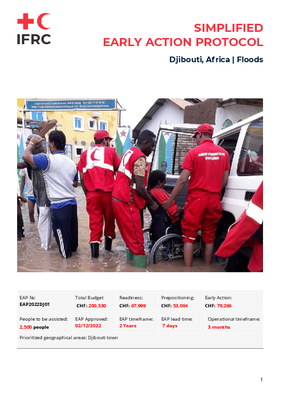Simplified Early Action Protocol for Floods - Djibouti, Africa
The vast majority of Djibouti’s rural population is highly susceptible to climatic uncertainty – they live in deserts or marginal and infertile areas, often with highly erodible soils, poor ground cover, and limited water supplies where food security is a serious concern. The major hazards in Djibouti are floods, droughts, sea level rise, and epidemics, whose frequency, occurrence, and impacts have increased in recent years, and already pose a significant risk to the country’s vulnerable population.
Floods and drought are the two main hazards affecting Djibouti. This first simplified EAP will address floods mainly as a result of flash floods and seasonal rivers and runoff from hills forming streams in the basement valleys later, based on this experience, the National Society will consider working on a drought-simplified EAP.
Floods are one of the exacerbated hazard effects of global climate change and Djibouti is at risk of both flash floods due to the topographic nature of its landscape of volcanic formations and seasonal riverbeds and tributaries draining to the ocean as well as oceanic effects of climate change including sea level rise, floods and relative Tsunamis making Djibouti one of the non-island high-risk countries. These features contribute to the vulnerability and exposure of Djibouti to increased intensity floods in the event of heavy rains.

Resource Type
PDF, 1.19 MB
Year
2022
Country
Djibouti
Region
Africa
Content Type
Other
Theme
Early Action
Organization
IFRC
Hazard
Flood

